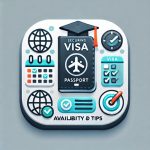How to Apply for a US Visa: A Complete Guide The US has long been seen as a place of opportunity, drawing people from all over the world who want to live, work, or study there. But getting a US visa can be a difficult and complicated process. Anyone thinking about taking this route needs to be aware of the complexities surrounding the US visa application process. Knowing the different kinds of visas that are available—which can be roughly divided into immigrant and non-immigrant visas—is the first step in the process. While non-immigrant visas are designed for people looking to temporarily enter the country for reasons like business, education, or tourism, immigrant visas are meant for people who want to live in the US permanently.
It is imperative that applicants familiarize themselves with the particular type of visa they are pursuing, as each category of visa has its own set of requirements and procedures. In addition, there are a number of rules and guidelines that control the US visa application process, and they can change regularly. This implies that those who are considering applying for a visa need to be aware of any changes or updates to the application procedure. With comprehensive details on visa categories, application processes, and eligibility requirements, the US Department of State website is a priceless resource.
It’s also critical to comprehend how embassies and consulates function in the visa application process. These organizations play a crucial role in assessing an applicant’s eligibility for entry into the United States since they are the first to process visa applications and hold interviews. People can improve their chances of a successful application and more adeptly handle the intricacies of the US visa process by understanding these fundamental components.
It is essential to determine one’s eligibility for a particular type of visa before starting the application process. Knowing the requirements is essential for a successful application, as eligibility criteria differ greatly based on the type of visa. For example, evidence that one intends to return to their home country following a brief stay in the US is frequently required for non-immigrant visas.
Demonstrating connections to family, work, or property in the applicant’s native country may fall under this category. On the other hand, immigrant visas, which frequently call for sponsorship from a family member or employer, demand a deeper commitment to living in the US. Determining which visa category best suits their objectives requires applicants to carefully consider their circumstances and motivations. Candidates must take into account any legal or procedural obstacles that might impact their eligibility in addition to their unique situation. An individual’s chances of obtaining a visa can be greatly impacted by things like prior immigration infractions, criminal histories, or health-related concerns.
It would be wise for applicants to learn how these factors might affect their eligibility by doing extensive research and perhaps speaking with an immigration lawyer. Also, availability may be impacted by numerical restrictions or quotas associated with specific visas, especially those for immigrants. One can make well-informed decisions regarding their visa applications and steer clear of potential pitfalls by carefully considering both personal qualifications and external factors. Filling out the Visa Application. Filling out the actual visa application is the next step in the US visa procedure after eligibility has been determined. Since it establishes the framework for the entire application process, this step is crucial.
The particular form needed will vary depending on the kind of visa being applied for; for instance, applicants for non-immigrant visas usually fill out Form DS-160, but those for immigrant visas might have to fill out Form DS-260. delivering truthful and accurate information. Comprehensive details regarding the applicant’s background, travel itinerary, and financial situation are required on each form. Sincereness and accuracy are crucial at this point, as any inconsistencies or omissions may result in delays or even rejections. Applicants must complete the application form & obtain supporting documentation to back up their statements and goals.
Compiling supplementary information. Financial statements, evidence of employment or enrollment in an educational program, & any other pertinent documentation proving ties to their home country or qualifying them for the particular visa category can be included in this. It is crucial to carefully adhere to the US Department of State’s guidelines; otherwise, issues may arise later. guaranteeing a seamless application procedure.
Applicants can improve their chances of a seamless application process by approaching this step with diligence and attention to detail. After completing the application and obtaining the required paperwork, candidates need to make an appointment for a visa interview at a U.S. embassy or consulate. Candidates have the chance to make their case in person during this step, which is frequently regarded as one of the most important parts of the visa application process. The location and type of visa being applied for can affect the scheduling procedure; some embassies may offer online appointment scheduling, while others may require phone calls or in-person visits to schedule an interview. Because wait times can vary greatly depending on demand and local circumstances, it is best to make this appointment as soon as possible.
Applicants should also consider any special instructions given by the embassy or consulate regarding necessary paperwork and costs when setting up the interview. There might be extra conditions or steps that need to be taken in certain places before the interview date. Also, it is crucial to verify that all required fees have been paid and that receipts are retained for future reference. The stress of the visa application process can be reduced for applicants by being proactive in planning and preparing for this important step. Success in the visa interview depends on preparation; this includes knowing what to anticipate during the interview as well as assembling the necessary paperwork.
Candidates should acquaint themselves with typical interview questions pertaining to their particular situation & visa category. Inquiries can cover everything from financial security and travel schedules to more intimate topics like family relationships and future plans in the US. Candidates can communicate their intentions more confidently and clearly during the actual interview by practicing their answers to these questions. In addition to preparing responses to possible questions, candidates should make sure that all necessary paperwork is arranged and ready to be shown during the interview. This comprises the application confirmation page as well as any supporting documentation that backs up their claims, such as bank statements, employment or educational records, and any other pertinent materials. Having a well-organized application can show the interviewing officer that you are serious about it and prepared.
Finally, being well-prepared can greatly improve an applicant’s performance and confidence at this crucial stage of the visa application process. For candidates, the day of the visa interview can be both thrilling and nerve-racking. It is essential to get to the embassy or consulate well in advance, as this allows for any last-minute delays like lengthy lines or security checks. Prior to entering the waiting area and waiting for their turn for an interview, candidates usually undergo security screening upon arrival.
Anxiety can impair performance during the actual interview, so it’s critical to maintain composure during this time. Applicants should approach the interviewing officer with professionalism and confidence when they are called for an interview. Most likely, the officer will start by going over the application and posing queries in light of its contents. Candidates must answer intelligibly and concisely, keeping eye contact and exhibiting positive body language. Instead of speculating or giving false information if there are any doubts about the questions posed, it is totally appropriate to ask for clarification. Communicating sincerity & openness throughout the exchange is crucial because it may have a big impact on the officer’s decision to approve the visa.
Following the visa interview, candidates frequently experience a sense of anticipation while they wait for their application to be decided. Depending on a number of variables, such as the type of visa, the particular situation, and the processing times at particular embassies or consulates, the processing time can vary significantly. The length of time applicants should anticipate waiting for a decision is often communicated to them during the interview; however, if there are substantial delays beyond this period, it is advisable to consult online resources or get in touch with the embassy.
Applicants will be informed via the communication channel of their choice—usually email or an application-related web portal—as soon as a decision has been made on their visa application. If accepted, instructions will be given on how to pick up their passport with the visa attached; if rejected, a letter explaining the reasons for the denial will be sent, along with information about the possibility of reapplying in the future. It’s critical to comprehend these follow-up protocols in order to control expectations after the interview & make sure that all required actions are taken as soon as possible in response to any results.
In summary, managing the US visa application process necessitates careful preparation, careful planning, and knowledge of every stage—from figuring out eligibility to following up following an interview. Prospective applicants can improve their chances of acquiring a US visa & starting their journey toward new opportunities in America by applying diligence and attention to detail to each step of the process.





